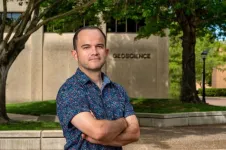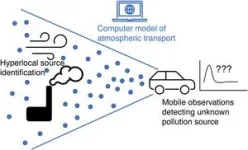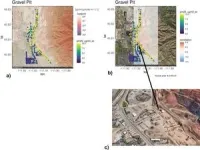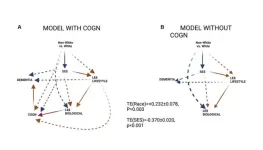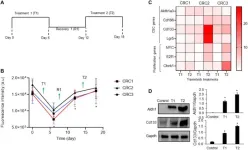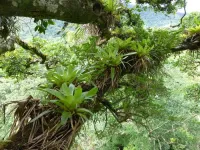(Press-News.org) With a population of 127 million and a land mass about a fifth the size of the United States, Mexico has a large spectrum of climates and landscapes, ranging from mountains to coastal regions and from deserts to glaciers. Because of these variations, it is important for communities to understand precipitation patterns to plan appropriately for weather events and water resources management.
A team led by Ricardo Sánchez-Murillo, associate professor of earth and environmental sciences at The University of Texas at Arlington, has created a new isotope database that includes 608 monthly rain samples (spanning 2018-22) from 21 monitoring stations across the country. The results of his work are published open access in the journal PLOS Water. Co-authors are from the Mexican Institute of Water Technology in Mexico City; the International Atomic Energy Agency in Vienna, Austria; and the Universidad de Vigo in Ourense, Spain.
For decades, most studies have relied on data archives from two stations in the Global Network of Isotopes in Precipitation that operated in Mexico from 1962-88. One station was in the city of Chihuahua (northern arid region); a second was in the city of Veracruz (southeastern wet region). This represents a relatively low number of monitoring stations for such a large and heterogeneous country, with abundant rain in the south and scarce precipitation in the north. Mexico has rain forests, vast deserts, tropical and mid-latitude climates, an enormous plateau bounded by two mountain ranges where ice caps are still present, and coastlines facing the Pacific Ocean, Gulf of Mexico, Gulf of California and Caribbean Sea, Sánchez-Murillo said.
Similarly, Mexico is affected by multiple climatic features, such as the influence of cold fronts, atmospheric rivers, easterly waves, tropical cyclones and northerly trade winds. All these topographic, geographic and weather characteristics are represented in a large spectrum of climatic regions across Mexico, he said.
The authors report on the spatial and temporal isotope variations of 21 precipitation monitoring stations across different physiographic units of Mexico. These stations are part of the National Network of Isotopes in Precipitation operated by the Department of Hydrology of the Mexican Institute of Water Technology.
“Our results fill a recognized historical gap in the precipitation isotope monitoring in North America” Sánchez-Murillo said. “This will provide a baseline for other researchers to pursue more detailed ecohydrological, climatic, forensic, archeological and paleoclimate studies across Mexico.”
END
Isotope database will help Mexican communities better understand hydrology processes
Project provides baseline for hydrological, ecological, archeological and paleoclimate studies
2023-10-11
ELSE PRESS RELEASES FROM THIS DATE:
Novel drug, NFX-179, inhibits MEK activity, prevents cutaneous squamous cell carcinoma development
2023-10-11
TAMPA, Fla. — Cutaneous squamous cell carcinoma is the second most common type of skin cancer in the United States, impacting approximately 700,000 people each year. While medications exist to prevent the development of disease, they are associated with side effects, suggesting the need for new drugs that can be safely used to prevent it. In a new article published today in Science Translational Medicine, a team of Moffitt Cancer Center researchers, in collaboration with NFlection Therapeutics and researchers at Stanford University, reports the ...
MD Anderson hosts 2023 Leading Edge of Cancer Research Symposium
2023-10-11
HOUSTON ― The University of Texas MD Anderson Cancer Center will host its annual Leading Edge of Cancer Research Symposium Nov. 16-17, 2023, featuring presentations and discussions on genomics, immunity and inflammation, computational approaches for spatial biology, and emerging technologies that are driving the next wave of cancer breakthroughs.
The in-person symposium at MD Anderson will include keynote presentations from Paul Mischel, M.D., professor of Pathology at Stanford University, Andrea Schietinger, Ph.D., associate professor of Immunology at Memorial Sloan Kettering Cancer Center, and Kevan Shokat, Ph.D., chair of Cellular and Molecular Pharmacology at University ...
NYU researchers reconstruct speech from brain activity, illuminates complex neural processes
2023-10-11
Speech production is a complex neural phenomenon that has left researchers explaining it tongue-tied. Separating out the complex web of neural regions controlling precise muscle movement in the mouth, jaw and tongue with the regions processing the auditory feedback of hearing your own voice is a complex problem, and one that has to be overcome for the next generation of speech-producing protheses.
Now, a team of researchers from New York University have made key discoveries that help untangle that web, and are using it to build vocal reconstruction technology that recreates the voices of patients ...
Oregon State to lead $2M federal push toward more-efficient, longer-lasting electrical components
2023-10-11
CORVALLIS, Ore. – Researchers in the Oregon State University College of Engineering are spearheading a $2 million federal effort to explore new ways of developing electrical components that are better able to withstand extreme operating conditions, especially high temperatures.
The team will try to find novel, artificial-intelligence-based methods for designing and building long-lasting, high-efficiency electrical components for harsh-environment applications such as high-power radar and the aerospace, automotive and wireless communications industries.
“The semiconductor ...
Group led by University of Alaska Fairbanks gets $13.9 million to aid coastal climate resilience
2023-10-11
The National Science Foundation is funding a $13.9 million program led by the University of Alaska Fairbanks to help multiple communities respond to coastal erosion, flooding, permafrost thaw and other hazards attributed to climate change.
The four years of funding is part of the foundation’s Navigating the New Arctic program.
The funding supports AC³TION, a project led by the Alaska Coastal Cooperative at UAF in collaboration with the rural coastal communities, Arizona State University, the University of Northern Iowa and the University of Texas El Paso.
The group’s acronym stands for Alaska Coastal Cooperative for Co-producing Transformative Ideas and Opportunities ...
New study finds link between subjective and objective memory decline
2023-10-11
MINNEAPOLIS – Among people who report memory and thinking problems, some show no signs of a problem on standard tests, while others have subtle declines on their tests. A new study shows that people who have subtle problems with these tests may have an increased risk of developing mild cognitive impairment, which can be a precursor to dementia. The study is published in the October 11, 2023, online issue of Neurology®, the medical journal of the American Academy of Neurology.
“Several studies have found that people with subjective ...
New guidance issued on the determination of brain death
2023-10-11
MINNEAPOLIS – New guidance has been issued for clinicians on the determination of brain death, also known as death by neurologic criteria. A new consensus practice guideline, developed through a collaboration between the American Academy of Neurology (AAN), the American Academy of Pediatrics (AAP), the Child Neurology Society (CNS), and the Society of Critical Care Medicine (SCCM) is published in the October 11, 2023, online issue of Neurology®, the medical journal of the American Academy of Neurology.
This guideline updates the 2010 AAN ...
Insights on disparities in dementia from the UK Biobank study
2023-10-11
“The present study is among few to examine racial/ethnic disparities in dementia risk and their related pathways [...]. It is the first to do so in a UK population.”
BUFFALO, NY- October 11, 2023 – A new research paper was published in Aging (listed by MEDLINE/PubMed as "Aging (Albany NY)" and "Aging-US" by Web of Science) Volume 15, Issue 18, entitled, “Pathways explaining racial/ethnic and socio-economic disparities in dementia incidence: the UK Biobank study.”
Pathways explaining racial/ethnic disparities ...
Suppression of cancer stemness and drug resistance via BRAF/EGFR/MEK inhibition in colorectal cancer cells
2023-10-11
“[...] our approach enables mechanistic studies of drug resistance with 3D cultures of primary cancer cells to develop and test treatments that suppress cancer [...].”
BUFFALO, NY- October 11, 2023 – A new research paper was published in Oncotarget's Volume 14 on October 4, 2023, entitled, “Inhibiting BRAF/EGFR/MEK suppresses cancer stemness and drug resistance of primary colorectal cancer cells.”
Drug resistance is a major barrier against successful treatments of cancer patients. Gain of stemness under drug pressure is a major mechanism that renders treatments ineffective. Identifying ...
Epiphytes, amazing plants like moss and bromeliads found in trees, face growing threats
2023-10-11
Orchids, mosses, ferns—or epiphytes, defined as nonparasitic plants that grow on other plants—are crucial for Earth’s biodiversity and play essential roles in forests around the world, building habitat in trees for myriad other life forms, from bacteria and insects to birds and reptiles.
However, the very attributes that have enabled epiphytes to thrive in forest canopies are now making them vulnerable to both natural and human-caused disturbances, according to Nalini Nadkarni, the University of Utah biologist renowned for her pioneering work studying and conserving treetop ecosystems.
In a study published this month, Nadkarni found these vital plants ...
LAST 30 PRESS RELEASES:
Tracing the quick synthesis of an industrially important catalyst
New software sheds light on cancer’s hidden genetic networks
UT Health San Antonio awarded $3 million in CPRIT grants to bolster cancer research and prevention efforts in South Texas
Third symposium spotlights global challenge of new contaminants in China’s fight against pollution
From straw to soil harmony: International team reveals how biochar supercharges carbon-smart farming
Myeloma: How AI is redrawing the map of cancer care
Manhattan E. Charurat, Ph.D., MHS invested as the Homer and Martha Gudelsky Distinguished Professor in Medicine at the University of Maryland School of Medicine
Insilico Medicine’s Pharma.AI Q4 Winter Launch Recap: Revolutionizing drug discovery with cutting-edge AI innovations, accelerating the path to pharmaceutical superintelligence
Nanoplastics have diet-dependent impacts on digestive system health
Brain neuron death occurs throughout life and increases with age, a natural human protein drug may halt neuron death in Alzheimer’s disease
SPIE and CLP announce the recipients of the 2025 Advanced Photonics Young Innovator Award
Lessons from the Caldor Fire’s Christmas Valley ‘Miracle’
Ant societies rose by trading individual protection for collective power
Research reveals how ancient viral DNA shapes early embryonic development
A molecular gatekeeper that controls protein synthesis
New ‘cloaking device’ concept to shield sensitive tech from magnetic fields
Researchers show impact of mountain building and climate change on alpine biodiversity
Study models the transition from Neanderthals to modern humans in Europe
University of Phoenix College of Doctoral Studies releases white paper on AI-driven skilling to reduce burnout and restore worker autonomy
AIs fail at the game of visual “telephone”
The levers for a sustainable food system
Potential changes in US homelessness by ending federal support for housing first programs
Vulnerability of large language models to prompt injection when providing medical advice
Researchers develop new system for high-energy-density, long-life, multi-electron transfer bromine-based flow batteries
Ending federal support for housing first programs could increase U.S. homelessness by 5% in one year, new JAMA study finds
New research uncovers molecular ‘safety switch’ shielding cancers from immune attack
Bacteria resisting viral infection can still sink carbon to ocean floor
Younger biological age may increase depression risk in older women during COVID-19
Bharat Innovates 2026 National Basecamp Showcases India’s Most Promising Deep-Tech Ventures
Here’s what determines whether your income level rises or falls
[Press-News.org] Isotope database will help Mexican communities better understand hydrology processesProject provides baseline for hydrological, ecological, archeological and paleoclimate studies
